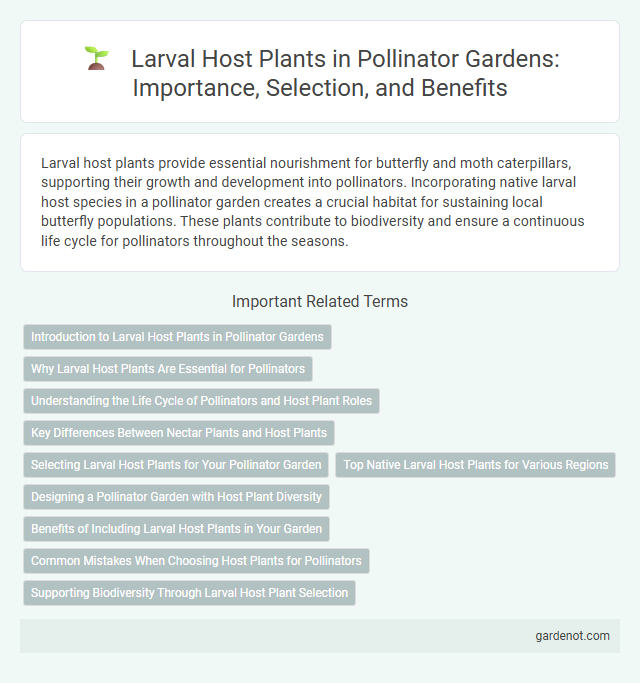Larval host plants provide essential nourishment for butterfly and moth caterpillars, supporting their growth and development into pollinators. Incorporating native larval host species in a pollinator garden creates a crucial habitat for sustaining local butterfly populations. These plants contribute to biodiversity and ensure a continuous life cycle for pollinators throughout the seasons.
Introduction to Larval Host Plants in Pollinator Gardens
Larval host plants play a crucial role in supporting pollinator gardens by providing essential nourishment and habitat for butterfly and moth caterpillars. These plants ensure the survival of pollinators from the egg stage through metamorphosis by offering leaves on which larvae feed and develop. Incorporating diverse native larval host plants enhances biodiversity and promotes a sustainable ecosystem for pollinator populations.
Why Larval Host Plants Are Essential for Pollinators
Larval host plants provide essential food sources for the caterpillars of many pollinator species, ensuring their survival and development into adult pollinators. Without these specific plants, the life cycle of butterflies, moths, and other pollinators can be disrupted, leading to population declines. Incorporating native larval host plants into pollinator gardens supports biodiversity and sustains healthy ecosystems.
Understanding the Life Cycle of Pollinators and Host Plant Roles
Larval hosts are specific plants where pollinator larvae, such as butterfly and moth caterpillars, feed and develop, playing a crucial role in their life cycle. Understanding the relationship between pollinators and their host plants enhances garden biodiversity and supports population sustainability by providing essential resources throughout different developmental stages. Incorporating native larval host plants in pollinator gardens ensures successful metamorphosis and promotes ecological balance within the habitat.
Key Differences Between Nectar Plants and Host Plants
Larval host plants provide essential nourishment for butterfly and moth larvae, supporting their growth and development, while nectar plants primarily offer nectar to adult pollinators. Unlike nectar plants, which attract a wide range of pollinators for feeding, larval host plants are often species-specific and critical for the survival of particular butterfly species. Understanding these key differences ensures the selection of appropriate plant species in a pollinator garden to support the full life cycle of pollinators.
Selecting Larval Host Plants for Your Pollinator Garden
Selecting larval host plants for your pollinator garden ensures the survival of native butterfly and moth species by providing essential food sources for their caterpillars. Opt for native plants like milkweed for monarchs, parsley for black swallowtails, and passionflower for gulf fritillaries to support localized ecosystems. Incorporating a diversity of larval host plants increases biodiversity and promotes healthy pollinator populations throughout the growing season.
Top Native Larval Host Plants for Various Regions
Top native larval host plants play a crucial role in supporting butterfly and moth populations across diverse regions. Species such as milkweed (Asclepias spp.) in the Midwest, oak (Quercus spp.) in the Eastern United States, and buckwheat (Eriogonum spp.) in the Southwest provide essential food sources for caterpillars. Selecting region-specific larval hosts enhances biodiversity and fosters a thriving pollinator garden ecosystem.
Designing a Pollinator Garden with Host Plant Diversity
Incorporating a variety of larval host plants is essential for designing a pollinator garden that supports the full life cycle of butterflies and moths. Selecting native species such as milkweed for monarchs and willow for viceroys ensures habitat diversity and encourages higher pollinator populations. A host plant-rich environment promotes biodiversity while providing critical resources for larvae to thrive and transform into pollinating adults.
Benefits of Including Larval Host Plants in Your Garden
Including larval host plants in your pollinator garden supports the complete life cycle of butterflies and moths, enhancing biodiversity. These plants provide essential nourishment for caterpillars, increasing local butterfly populations and promoting ecological balance. Growing native larval hosts also improves pollination success by attracting and sustaining pollinators throughout various developmental stages.
Common Mistakes When Choosing Host Plants for Pollinators
Choosing inappropriate larval host plants can significantly reduce pollinator garden effectiveness, as many caterpillars require specific native plant species for development. Common mistakes include selecting non-native or ornamental plants that fail to support local butterfly and moth larvae, leading to low survival rates. Ensuring accurate identification and sourcing of native larval host plants such as milkweed for monarchs or willow for mourning cloaks optimizes habitat suitability and biodiversity.
Supporting Biodiversity Through Larval Host Plant Selection
Selecting larval host plants in pollinator gardens enhances biodiversity by providing essential resources for butterfly and moth larvae, ensuring their survival and development. Native species like milkweed for monarchs and violet for fritillaries create specialized habitats that support diverse pollinator populations. Incorporating a variety of larval host plants strengthens ecosystem resilience and promotes a balanced food web.
Larval host Infographic

 gardenot.com
gardenot.com